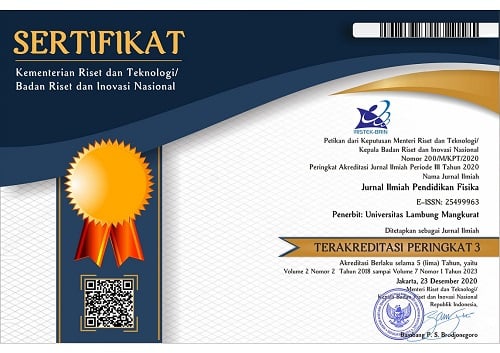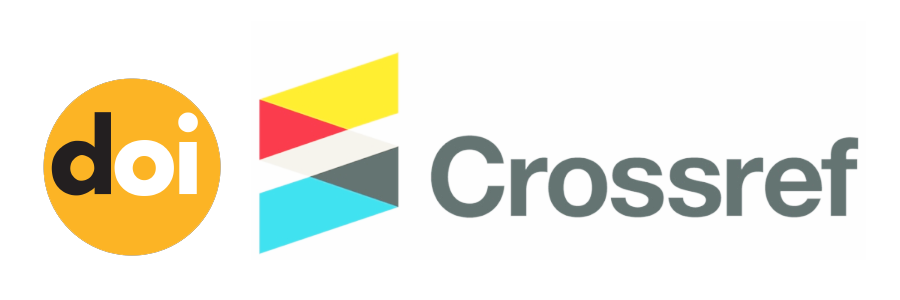The Effectiveness of Electronic Modules on Problem-Solving Oriented Work and Energy Topics to Improve Student Learning Outcomes
Abstract
Technological developments make the education sector need to present modern learning resources while facilitating students in dealing with problems in the 21st century. Thus, the research aimed to develop an electronic module on the topic of work and energy-oriented to effective problem-solving so that it can be used to improve student learning outcomes. This research is in the form of development research using the ADDIE model. The subjects of this research were 33 students of X MIPA 4 SMA Negeri in Banjarmasin. The data analysis technique used is descriptive quantitative with a learning outcomes test as the research instrument used. The research results explained that the electronic module was declared highly effective with an N-gain score of 0.76. Thus, the electronic module physics on work and energy-oriented problem-solving are feasible to improve student learning outcomes.
Keywords
Full Text:
PDFReferences
Aini, N., Zainuddin, Z., & Mahardika, A. I. (2018). Pengembangan materi ajar ipa menggunakan model pembelajaran kooperatif berorientasi lingkungan lahan basah. Berkala Ilmiah Pendidikan Fisika, 6(2), 264. https://doi.org/10.20527/bipf.v6i2.4919
Cahyani, A. E. M., Mayasari, T., & Sasono, M. (2020). Efektivitas e-modul project based learning berintegrasi stem terhadap kreativitas siswa smk. Jurnal Ilmiah Pendidikan Fisika, 4(1), 15. https://doi.org/10.20527/jipf.v4i1.1774
Candradewi, W. C., Dharsana, I. K., & Tegeh, I. M. (2020). Student teams achievement division technique and group investigation technique through lesson study enhancing students learning outcomes. International Journal of Elementary Education, 4(3), 310-320.
Damayanti, A., & Tarmedi, E. (2018). Implementing cooperative script type of cooperative learning model to improve students’ activeness in learning social studies. International Journal Pedagogy of Social Studies, 3(1), 129–136.
Fahrina, F., Jamal, A., & M, A. S. (2018). Meningkatkan kemampuan analisis sintesis siswa kelas x mia 6 sma negeri 2 banjarmasin melalui model pengajaran langsung dengan metode problem solving. Berkala Ilmiah Pendidikan Fisika, 6(1), 98.
https://doi.org/10.20527/bipf.v6i1.3897
Gaigher, E., Rogan, J. M., & Braun, M. W. H. (2006). The effect of a structured problem solving strategy on performance in physics in disadvantaged south african schools. African Journal of Research in Mathematics, Science and Technology Education, 10(2), 15–26. https://doi.org/10.1080/10288457.2006.10740601
Hake, R. R. (1998). Interactive-engagement versus traditional methods: A six-thousand-student survey of mechanics test data for introductory physics courses. American Journal of Physics, 66(1), 64–74. https://doi.org/10.1119/1.18809
Herawati, N. S., & Muhtadi, A. (2018). Pengembangan modul elektronik (e-modul) interaktif pada mata pelajaran Kimia kelas XI SMA. Jurnal Inovasi Teknologi Pendidikan, 5(2), 180–191. https://doi.org/10.21831/jitp.v5i2.15424
Jainuri, M. (2014). Kemampuan pemecahan masalah matematika. Acamedia, 1(1), 1–8.
Jufri, W. (2017). Belajar dan pembelajaran sains. Pustaka Reka Cipta.
Maisaroh, M., Mayasari, T., & Sasono, M. (2020). Pengembangan modul elektronik berbasis real life learning untuk meningkatkan kemampuan analisis siswa smk. Jurnal Ilmiah Pendidikan Fisika, 4(1), 33. https://doi.org/10.20527/jipf.v4i1.1776
Misbah, M., Khairunnisa, Y., Amrita, P. D., Dewantara, D., Mahtari, S., Syahidi, K., ... & Deta, U. A. (2021). The effectiveness of introduction to nuclear physics e-module as a teaching material during covid-19 pandemic. Journal of Physics: Conference Series, 1760(1), 012052. IOP Publishing.
Mubarok, A. Z. Z., Ismet, I., & Kistiono, K. (2022). Pengembangan modul elektronik fisika untuk meningkatkan kemampuan berpikir kreatif peserta didik pada materi hukum newton. Jurnal Ilmiah Pendidikan Fisika, 6(1), 87–98.
Nur Syamsu, F., Rahmawati, I., & Suyitno, S. (2019). Keefektifan model pembelajaran stad terhadap hasil belajar matematika materi bangun ruang. International Journal of Elementary Education, 3(3), 344. https://doi.org/10.23887/ijee.v3i3.19450
Prasetyaningtyas, S. (2015). Penerapan model pembelajaran koperatif stad untuk meningkatkan keaktifan dan prestasi belajar ipa pada materi pewarisan sifat siswa kelas ix smp negeri 1 …. Prosiding SNPS (Seminar Nasional …, November, 430–442. https://jurnal.fkip.uns.ac.id/index.php/snps/article/view/8310
Purwanto, M. N. (2010). Prinsip-prinsip dan Teknik Evaluasi Pengajaran.
Puspitasari, A. D. (2019). Penerapan media pembelajaran fisika menggunakan modul cetak dan modul elektronik pada siswa sma. Jurnal Pendidikan Fisika, 7(1), 17–25.
Putri, H. E., & Usmeldi, U. (2020). The development of e-modules problem based learning using goole classroom for basic electricity and electronics at vocational school. Cyberspace: Jurnal Pendidikan Teknologi Informasi, 4(2), 84. https://doi.org/10.22373/cj.v4i2.7861
Rahmatullah, A. S., Mulyasa, E., Syahrani, S., Pongpalilu, F., & Putri, R. E. (2022). Digital era 4.0: The contribution to education and student psychology. Linguistics and Culture Review, 6(S3), 89-107.
Rizaldi, W. R., Sudirman, Pasaribu, A., & Saparini. (2022). Pengembangan modul elektronik alat-alat optik berbasis stem menggunakan aplikasi flip pdf professional. Jurnal Ilmiah Pendidikan Fisika, 6(2), 360–367.
Rizki, M., Wati, M., & Misbah, M. (2021). Electronic thermodynamics teaching materials based on authentic learning to practice students’ problem-solving skills: Aspects of validity. Journal of Physics: Conference Series, 2104(1), 012018. IOP Publishing.
Saputri, S. R., Wati, M., & Misbah, M. (2021). Simple harmonic motion electronic teaching materials based on authentic learning to train students’ problem-solving skills: aspects of validity. Journal of Physics: Conference Series, 2126(1), 012016. IOP Publishing.
Sari, N., Annur, S., & Mahardika, A. I. (2017). Pengembangan lks pembelajaran fisika dengan menggunakan model clis (children learning in science) di smp 1 muhammadiyah banjarmasin. Berkala Ilmiah Pendidikan Fisika, 5(2), 159. https://doi.org/10.20527/bipf.v5i2.2872
Sima, V., Gheorghe, I. G., Subić, J., & Nancu, D. (2020). Influences of the industry 4.0 revolution on the human capital development and consumer behavior: A systematic review. Sustainability, 12(10), 4035.
Song, S. J., Tan, K. H., & Awang, M. M. (2021). Generic digital equity model in education: Mobile-assisted personalized learning (MAPL) through e-modules. Sustainability, 13(19), 11115.
Sudarwo, P. R. (2017). The effect of STAD cooperative learning and expository methods and learning independence on educational statistics learning outcomes. Journal of Education and Practice, 8(35), 130-140.
Sugiyono, S. (2013). Metode penelitian pendidikan. Alfabeta.
Vitrianingsih, D., Aulianingsih, I., & Yuliani, H. (2021). Analisis kebutuhan pengembangan modul elektronik (e-module) ipa terintegrasi islam. Jurnal Ilmiah Pendidikan Fisika, 5(1), 27. https://doi.org/10.20527/jipf.v5i1.2525
Wati, L., Rahimah, R., Nengsih, E. W., & Mardaya, M. (2021). Media pembelajaran majalah fisika terintegrasi nilai keislaman. Jurnal Ilmiah Pendidikan Fisika, 5(2), 192. https://doi.org/10.20527/jipf.v5i2.2731
Wening, S. (2010). Bahan perkuliahan evaluasi belajar mengajar.
Winarso, W. (2016). Assessing the readiness of student. Jurnal Pencerahan, 10(2), 81–94.
DOI: https://doi.org/10.20527/jipf.v7i1.7311
Refbacks
- There are currently no refbacks.
Indexed by: Jurnal Ilmiah Pendidikan Fisika is licensed under a creative commons attribution-share alike 4.0 international license
Statistics Counter |
















